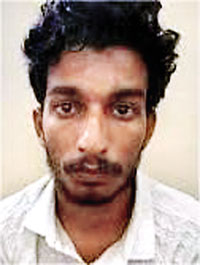Columns
Mystery of the missing 323 red flagged containers continues to rock the nation
View(s):The existence of God can never be proved either true or false. It is only faith that makes us believe that God exists, that there’s life after death, and that there’s a heaven and a hell beyond this earthly realm. As Shakespeare said, ‘The undiscovered country from whose bourne no traveller returns.’
Or to put it plainly, ‘What the eye does not see, the mind doesn’t know.’ And cannot and never will know. So what divine eyes do mortal men have to penetrate steel containers and unambiguously identify what exactly lies stored inside unopened steel containers? That is the question: to see or not to see?
Denied such divine sight to divine what’s within suspicious containers, the release of 323 red-flagged containers through the Green Channel in January this year, without being physically examined as mandatorily required, continues to remain an active volcano liable to blow its top any day.
Four months before MP Archchuna made his explosive allegation in Parliament last week that among the 323 red-flagged containers released from port was one that held an LTTE weapons haul acquired prior to Prabhakaran’s death, there had been disquiet as to who ordered the release of containers that had to be physically checked before receiving the green light to exit the Colombo Port.
On January 12, two days before President Anura Kumara is due to leave on his China trip, he summons senior Customs figures of the Colombo port to the presidential office and issues the presidential command: ‘Clear the port’s delay within four days.’
On the same day, a government press release states, ‘To expedite the clearance process, Sri Lanka Customs officers agreed to operate continuously,’ 24 hours a day, seven days a week. Two days later, Port Minister Bimal Rathnayake visits the port and informs reporters, ‘It is not 24 but 30 ships that have bypassed the Colombo port.’
His Deputy Minister, Janitha Kodithuwakku, adds, ‘Thirty cargo ships have turned back due to delays in container clearance.’ Furthermore, he says, ‘We have given orders to release 600 to 800 containers immediately.’
Ten days after the President had ordered Customs officials to clear the port backlog, the Customs Trade Union Alliance makes the startling announcement on January 22 that it will not take any responsibility whatsoever for the goods held in the 323 containers which had been red- flagged by the computer system but had been mysteriously cleared and released from port.
Its president Amila Sanjeeva tells news reporters at the press conference, ‘The containers marked in red by the computer system were flagged for higher inspection. Once red-flagged, these 323 containers required mandatory inspection. But it had been cleared and released without any mandatory inspection done.’
Furthermore, he declares, ‘The union will not bear any responsibility if these containers are found to contain low-quality medicines, cosmetic items deemed unfit for use, illegal cigarettes, other illegal imports, drugs or even weapons.
‘On whose legal authority’, he asks, ‘and under what law were the 323 red-flagged containers released from the port?’
On January 24, the Deputy Minister of Port, Kodithuwakku, confirms in Parliament the release of 323 red-flagged containers and, what’s more, says, ‘The government would assume full responsibility for the recent release of 323 containers from Sri Lanka Customs without inspection.’
Would Kodithuwakku assuming full responsibility matter one jot, should the potential damaged drugs or guns could do if unleashed, were, indeed, unleashed on the streets to wreak havoc?
On January 29, the Director General of Sri Lanka Customs, Sarath Nonis, confirms the release of 323 red-flagged containers without checking from the Colombo port. In a statement issued, he states, ‘The containers were released by the Screening Unit under the relevant criteria as per the advice of the committee while also considering the advice of the President and the committee chair, Minister Bimal Rathnayake, on Jan. 12, 2025.’
Of the thousand or more containers that land in the port daily, these 323 containers have been specifically chosen, not by human hand on a hunch but by the port’s sophisticated computer system, which had red-flagged these containers as requiring a mandatory physical check. The computer colour coding stands for:
1. GREEN; not necessary to carry out any inspections.
2. BLUE: Released without physical check but can be checked later at the warehouse
3. AMBER: Scanned inspection or physical check or both if considered necessary
4. RED: Mandatory physical inspection required
Customs Director Nonis seeks to defend this system on the doctrine of necessity. But how did he determine what’s inside a red-flagged container without laying his eyes on its contents?
In the wake of MP Archchuna’s claim in Parliament last week, hitting the hornets’ nest, the need to balm the sting has arisen, it seems.
Four months after the scandal of ‘323 red-flagged containers being cleared from port without any mandatory physical check’ had broken out in the public domain, the Port’s media spokesman, the Additional Director General of Customs, Seevali Arukgoda, broke his vows of four months’ silence to emerge from his cloistered enclave to shed new light on the scandal of the ‘vanished 323 red-flagged containers’.
Seevali Arukgoda said the 323 controversial shipping containers released without inspection were industrial goods and raw materials, according to the documents declared by the importers before they were released.
He spoke for the flock when he said, ‘Sri Lanka Customs believe the contents were as declared by the importers and can assure the containers did not carry arms or drugs.’
He stated that all necessary steps were taken to release the containers only after thoroughly checking the import documents. He affirmed that, due to the procedures followed by Customs, he believes the containers did not contain any illegal items.
Arukgoda added: “These imported containers contained raw materials needed for industries, such as plastics, yarn, chemicals, automobile spare parts, animal feed, machinery, pesticides, cement, iron pipes, fertilisers, and wood.
He ended his ‘shedding of light’ ritual on the controversial issue by stating, ‘I can confirm that no external or political party influenced the container release process. I can say that with absolute certainty.’
With such a testament to his faith and beliefs, how can anyone have the heart to deny him his claim? Except to clarify a point or two.
For instance, how did he determine what’s inside a red-flagged container without laying his eyes on its contents? Did he consult the Vestal Virgins of Rome or ask Pythia, the Oracle of Delphi, to run their divine eyes through each of the 323 red-flagged containers, or seek recourse to a local light reader and borrow his crystal ball?
Do not the Catholic faithful say, ‘Trust thy Lord but lock thy doors? Should not Arukgoda have trusted importers but physically checked their goods as well since it was mandatorily required? And, as for anyone exerting political pressure, God forbid, who ever thought that it was possible at Port?
| Easter bomb victims compensationWith reference to the article regarding compensation for Easter bomb victims in last week’s Sunday Punch 3, the relevant paragraph should be: The quest to compensate Easter bomb blast victims in monetary terms by virtue of the Fundamental Rights cases which had been instituted before their Lordships of the Supreme Court, has finally ended. | |
Honeymoon bride with murder on her mind and lover in her heart
- Honeymoon turned murder mystery shocks India
What should have been a romantic holiday for a young Indian honeymoon couple among Meghalaya’s lushy mountains has tragically ended at the bottom of a ravine for the groom, with the bride, accused of having his blood on her bridal hands, facing the hangman’s noose.
On Monday the mystery of the missing honeymoon couple that had rocked India for the last two weeks unhappily ended with the honeymoon bride unveiled as a scheming vixen who had planned his death even before the wedding.

BLOODYMOON AFTER WEDDING JOY: Groom’s body found dumped in a gorge while bride is nabbed with his blood on her hands
Sonam and Raja first made the news on October 1st last year, when their names were published as part of a community ritual in a booklet that listed the names of those eligible to be on the marriage market. Sonam’s mother jotted down Raja’s name while Raja’s mother wrote Sonam’s name. Neither family realised that Fate had written not the names of a prospective bride and groom but those of a killer and her victim.
The families had never met before, but the published profiles fitted the bill. Sonam was 24 and Raja, 28. The couple met, they saw, they liked and agreed to wed. As the traditional belief held, if love didn’t bloom at first sight, then it would take root and blossom in late summer. Raja’s mother called it ‘the perfect arranged match’ and said, ‘No love affair, no hidden motive.’ Though it may be true for marriages arranged in heaven, it certainly wasn’t for one made in hell.
Sonam’s father,Devi Singh, has built his plywood factory into a successful concern with a turnover of 250 million Indian rupees each year. Sonam, who had once harboured ambitions of studying for an MBA, managed every department of the family business with a hands-on approach.
Two or three years ago, a man named Raj Kushwaha had worked in the billing department of Sonam’s father’s factory. He also lived near Sonam’s home. As the months passed, he had become more than a clerk in the factory’s billing department. This year he would become the co-mastermind of a murder plot, one hatched by two lovers in two different social worlds.

RAJ KUSHWAHA; Secret lover in the love triangle
Raja Raghuvanshi was the youngest of three brothers. His two elder brothers, Sachin and Vipin, were married. Raja managed the family business, ‘Raghuvanshi Transport’, renting buses to schools and coaching institutes which the family had for nearly 20 years. According to reports, he was ‘diligent, responsible, and ready for a new chapter in his life: marriage.’
But the new chapter he opened that day turned out to be his last. Plans to murder him on his honeymoon had already been laid by his soon-to-be bride even before the wedding had begun.
The couple celebrate their wedding on 11th May and immediately leave on their honeymoon to the mountainous regions
of Meghalaya. Three hired hitmen also head for the same destination. Unbeknownst to the groom, on one leg of the long flight to Meghalaya, they even travel on the same airplane.
Once in Meghalaya, Sonam and Raja spend their days wrapped in love’s joyous embrace, as honeymooners often do. They regularly call their families back home and keep them abreast of how much they thoroughly enjoy their carefree ways of blissful days, ensconced in the heart of the hills.
That is, until May 23. The calls come to a sudden halt. A blanket silence falls. The couple seems to have disappeared from the face of the earth, with all communications suddenly cut off. When repeated attempts to establish communication fail to elicit any response, the parents begin to panic. The two families that were united in joy just a few days ago become united in worry and fear. The couple are reported “missing” on May 23rd to the police, but searches draw a blank. The families, in their frustration, criticise the Meghalaya government for not acting swiftly.
However, on June 2, the vital breakthrough was made. The badly decomposed body of Raja was found in a deep gorge near a waterfall in Sohra, East Khasi Hills district. His head appeared to have been struck with a machete before being thrown into the gorge. But not a clue was found about the bride, Sonam.
As later events would relate, Sonam was on the run, fleeing the scene of a grisly crime with her three hired hitmen. Police later pieced together the convoluted trail they left behind. As the Hindustan Times reports, ‘Sonam had driven from Shillong to Guwahati and then boarded a train to Indore, reaching the city by May 27. The next day, May 28, she travelled to Ghazipur, hometown of her alleged lover Raj Kushwaha, where she was eventually arrested on June 9.’
Sonam had claimed at first that Raja’s killing was due to a robbery gone wrong. Police found it ironic that while her husband’s gold chain had, indeed, been robbed, Sonam’s had been left untouched. She had also claimed that, after the incident, she had been drugged and then kidnapped. The mystery deepened.
Instead, they arrested her accomplice, Raj Kushwaha, her lover and mastermind of the diabolical murder plot, who ominously stayed in the background to give himself an ironclad alibi. According to police reports, Raj was even seen at Sonam’s family home while the police were combing Meghalaya’s hills for a trace of the missing honeymoon couple. Kushwaha was also spotted in a video clip, helping Sonam’s distraught father during his son-in-law’s funeral.
After holding out for 3 days, Sonam broke her silence and said, ‘I did it’ during police interrogation. It transpired that she had planned the murder of her intended groom and hired 3 hitmen to kill him, even before the wedding day.
But even before her admission, Sonam’s own brother had declared, ‘I am 100 per cent convinced she is guilty. My sister must go to the gallows.’ The mother of Raj Kushwaha weepingly said, ‘My son is innocent. My son would give away his footwear if he saw someone walking barefoot. I would scold him. I would tell him I won’t give you food, but he would still donate.’
It was, however, left to murdered Raja’s sister to ask the question all India is asking: ‘Why didn’t Sonam elope if she liked someone else?’
Buying or selling electronics has never been easier with the help of Hitad.lk! We, at Hitad.lk, hear your needs and endeavour to provide you with the perfect listings of electronics; because we have listings for nearly anything! Search for your favourite electronic items for sale on Hitad.lk today!


Leave a Reply
Post Comment